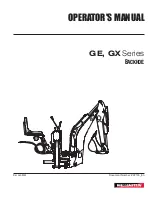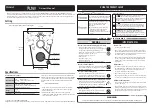
8
CHAPTER 5. SET-UP AND CALIBRATION
OPERATION
The VRF™ unit will begin operating when powered up. The sensitivity, fail-safe, and time delay settings
can be made without power applied. Recalibration will require that the unit be powered. Changes to
the sensitivity, fail-safe, and time delay do not require a recalibration.
SETTINGS AND ADJUSTMENTS
FAIL-SAFE SELECTION
The VRF™ is shipped from the manufacturing facility in the high level fail-safe condition. This setting is
made on DIP switch SW1, position 5. See Figure 4.1 in Chapter 4.
HIGH LEVEL FAIL-SAFE OPERATION
DIP Switch SW1 position 5 is ON.
If the electrical power fails, the relay turns OFF. This indicates material as if the tank is full.
Relay status LED is ON when no material is present, and OFF when material is present.
Alarm LED (red) is OFF when no material is present, and ON when material is present.
Relay NC output contacts are open when no material is present and closed when material is present.
NO output contacts are closed when no material is present and open when material is present.
LOW LEVEL FAIL-SAFE OPERATION
DIP Switch SW1 position 5 is OFF.
Relay status LED is OFF when no material is present, and ON when material is present.
Alarm LED (red) is OFF when no material is present, and ON when material is present.
Relay NC output contacts are closed when no material is present and open when material is present.
Relay NO output contacts are open when no material is present and closed when material is present.
SENSITIVITY SETTING
The VRF™ is shipped from the manufacturing facility in the 2pF setting. This setting is made on DIP
switch SW1 positions 1 and 2. See Figure 4.1.
TIME DELAY SETTING
The VRF™ is shipped from the manufacturing facility in the minimum time delay setting. This setting is
made on DIP switch SW1 positions 3 and 4. This setting will delay the time between when the VRF™
unit senses material and the output relay changes state. The delay is only in this direction, regardless of
fail-safe setting. There will be no delay when the material leaves the probe. See Figure 4.1.












































